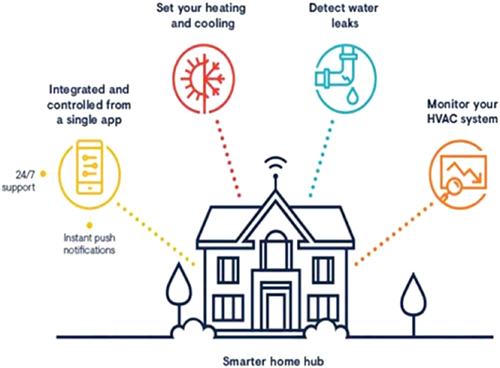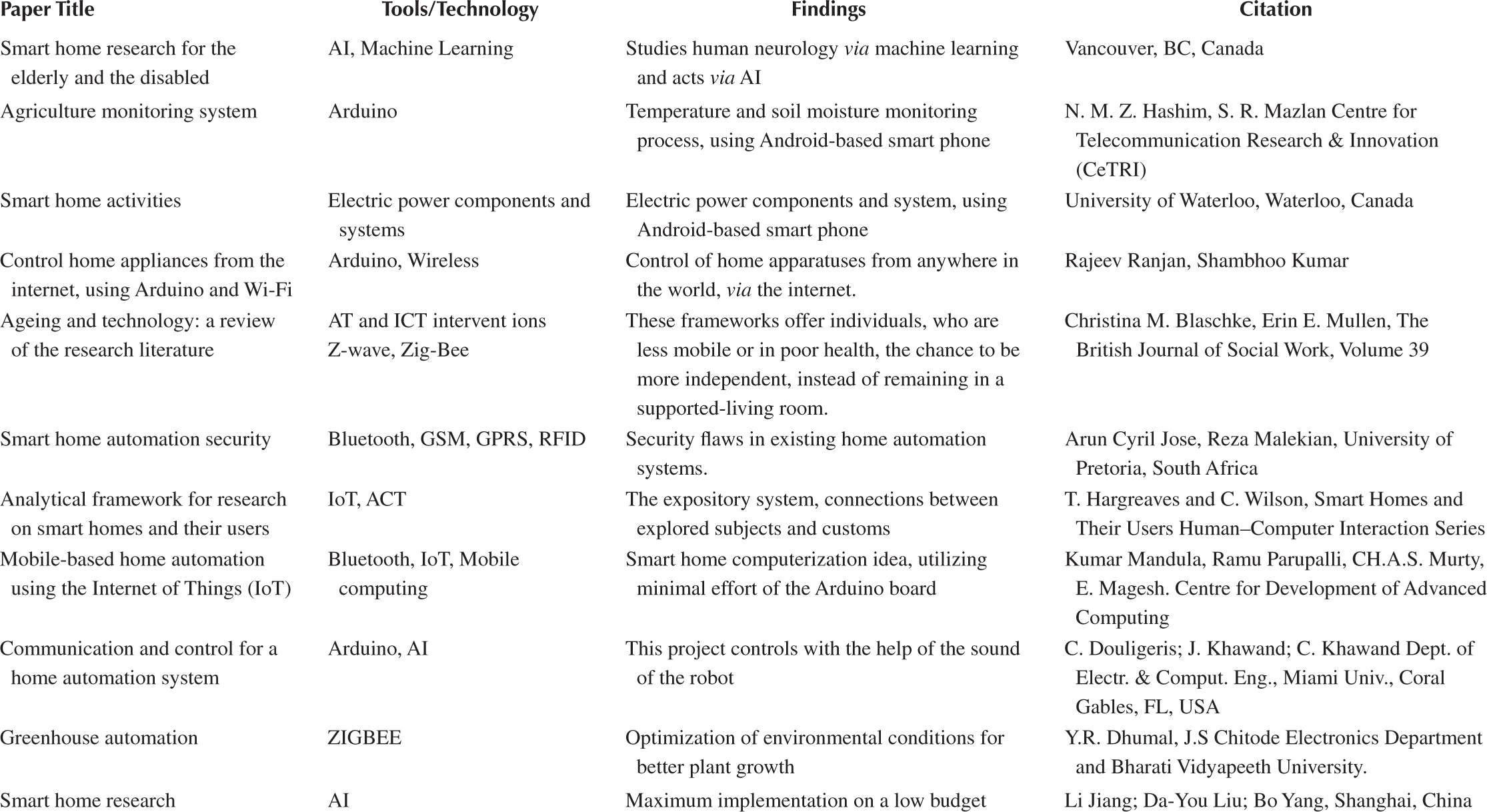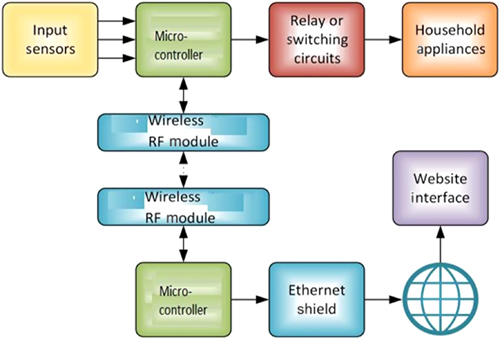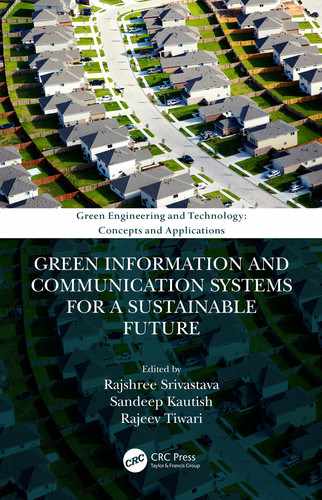11 Smart Home (Domotics)
Hemant Kumar Gianey and Sun-Yuan Hsieh
Contents
11.1.3 Smart Home Outcomes and Deliverables
11.2 The Emergence and Definition of the Smart Home
11.2.1 Existing System and Solutions
11.2.3 Tools and Technologies Used
11.3 Design and Components of Smart Home System
11.3.1 Environmental, Economic and Societal Benefits
11.5 Issues and Challenges of a Smart Home
After studying this chapter, you should be able to understand the concept of the smart home, its emergence and its definition, dimensions, and components in detail. Adoption of the Internet of Things (IoT) in automation is also explained in detail, along with design strategies. In the last section, various issues and challenges, associated with smart homes and different apps, are also discussed in detail. With the assistance of the IoT, we will be looking at the cutting edge innovations that we have encountered or forward to the future ideas that will change our everyday home lives into smart home living. Since its inception, the smart home concept has developed from the execution of explicit tasks to the use of procedures to handle more extensive city challenges worldwide. So, we need to study the concept of the smart home in light of various issues, their challenges and different applications of the smart home idea.
11.1 Introduction
The IoT involves utilizing various sorts of devices, made by various manufacturers and having different features. From its origins, which focused on individual improvements to the conventional home, exploiting the potential of IoT, the smart home concept has developed from the single building to the development of communities, capable of handling the issues associated with the challenges faced by city living. These days, home automation or robotization frameworks are being utilized to an ever-increasing extent, with many people becoming interested in making their homes more user friendly and secure. On one hand, these frameworks provide increased security and peace of mind; on the other hand, these frameworks, when presented as business structures, improve not only security and comfort, but also permit centralized management. Therefore, these systems contribute to overall reductions in cost and increases in energy and resource efficiency, which are really important issues nowadays.
Some current smart home frameworks depend on wired innovation; a standard automation or robotization framework does not take long to install if the framework has been planned prior to the build and inserted throughout the development of the building. If an existing building needs to have the automation system retrofitted, this needs a lot of effort and cost, since cabling is critical and costly. Wireless systems could assist here. In recent years, different wireless advances have occurred. Frameworks dependent on wireless advances are being utilized each day and everywhere. A comparative review of wireless norms has been carried out, and such information will provide significant help to anybody looking for the most appropriate framework for given tasks.
11.1.1 Concept of Smart Home
A smart or sensible home allows users to achieve increased resource efficiency and make financial savings by managing lights, window covers, and by monitoring. Various technologies from the smart phone have extended the users’ interest in management of major devices. The machine-manageable device allows users to perform tasks before reaching the home/office. A smart home system provides solutions for particular tasks using various technologies, particularly valuable for the physically disabled or older, less able people, using smart phone apps. According to a report, almost 70% respondents said that self-adjusting thermostats and doors that could be locked remotely from a distant location are the most important functions among the smart home gadgets.
The key advantage, resulting in the home-owner inclining toward this system over equivalent non-smart sorts of devices, is that the alerts sent by the smaller-scale controller associated with Wi-Fi are regularly received by the user or customer on the phone from any distance, whereas long-range interpersonal communication sites like Twitter can additionally be exploited to send message alarms to the client.
A smart home system manages the integrated systems in the home. The modules in these systems are managed by users using interface devices like a smart phone. The project emphasizes essential aspects of our everyday lives. Various sensors could be managed and monitored and can be adjusted easily. The system can be accessed locally or remotely from any versatile or hand-held device associated with the web. Wi-Fi development is selected to be the framework establishment that interfaces the server with the sensors. Wi-Fi is selected to update the framework security and to extend system flexibility and versatility. The home mechanization framework has the ability to deal with the following sectors in the client’s home and to send alerts: temperature, motion detection, fire and smoke identification, lights, fans, air conditioner system, water-pump, and so forth. The framework has a straightforward plan and program, and it requires hardly any input from the client, yet it is customized for the client’s individual needs.
11.1.2 Needs of a Smart Home
The primary objective of a smart home system, using IoT, is one which is capable of managing household appliances through an easily handled interface, providing an automated system to manage home devices wirelessly, effectively, and efficiently, with the following goals:
- i. To deliver an uninterrupted output.
- ii. To manage home devices via a button.
- iii. To manage the system through Wi-Fi.
- iv. To offer an extensible platform for future expansion and enhancement.
- v. To optimize a critical monitoring system.
We are living in a time with so many technological advancements, which make our lives simpler; this is a blessing, considering the fast-paced lives most of us lead. In short, the technology allows the home user to manage his/her home even when away via a smart-phone or an iPad. A number of reasons for adopting a smart home are listed below, with ways they could benefit us (Figure 11.1):

- i. Safety and peace of mind:
- ii. Security and access management
- iii. Energy efficiency
- iv. Comfort and well-being
- v. Convenience and efficiency
11.1.3 Smart Home Outcomes and Deliverables
The following are the outcomes of the smart home system, which are designed based on the requirements and specifications of the client:
- i. Flexibility for new appliances and devices: Smart frameworks will, in general, be versatile with regard to the accommodation of new devices and technological advances. It does not make a difference with respect to how dynamic your devices are these days, as there will be more up-to-date, progressively noteworthy models created in the future.
- ii. Maximizing home security: When fusing security and surveillance is included in the smart home system, security should soar. There are huge numbers of alternatives possible, several of which are now being investigated.
- iii. Remote oversight: Managing all at-home devices from one location, the comfort issue is enormous. Having the alternative to keep the sum of the advances in your home controlled by one interface could be a gigantic step forward for development and domestic organization.
- iv. Extend effectiveness: Depending on how we design a smart home, it is possible to make it able to face future threats and development better.
11.2 The Emergence and Definition of the Smart Home
In this section, the smart home framework, the apparatuses, the various capacities, prerequisites, and different variables, are discussed to give a thorough portrayal of the smart home framework.
11.2.1 Existing System and Solutions
The current IR or Bluetooth remote oversights present in the market are, by and large, device specific, and the equivalent devices couldn’t be utilized properly. The frameworks dependent on Global System for Mobile (GSM) are expensive and similarly moderate in terms of the devices which can be controlled. Electrical devices which are controlled through Bluetooth cannot be supervised from a distant location. The problem with current home security/observation systems is also associated with the fact that clients are frequently away from home for long periods (Table 11.1).
TABLE 11.1
Literature Survey and Findings

11.2.2 Identified Problems
A major issue recognized in past investigations into the existing smart home framework is that, in the GSM-based framework, in the event that General Packet Radio Services (GPRS) is not accessible, the system will not work. Most of the current smart home systems use the GPRS structure, which is expensive. Some frameworks use Wi-Fi connections, yet, for the most part, they use Raspberry Pi for computing, the cost of which is also exorbitant. All things considered, the home computerization or robotization system does not offer some obvious options like management of outside lights.
11.2.3 Tools and Technologies Used
There are various strategies to regulate home devices, such as IoT-based home mechanization/robotization over the cloud, home computerization under Wi-Fi through the use of any cell phone, Arduino-based home automation and robotization, using progressed supervision, and radio frequency (RF)-based home robotization structures (Table 11.2).
TABLE 11.2
Consolidated Comparison Reports of all Systems

There are different Wi-Fi innovations like Wi-Fi 802.11a, 802.11b, 802.11g and 802.11n. Compared to other wireless communication techniques, NodeMCU possesses the benefits listed below:
- a) Low energy consumption;
- b) Low cost;
- c) Flexible
- d) Fast, easy deployment
- e) Security
- f) Product interoperability;
11.3 Design and Components of Smart Home System
The smart home system consists of micro-controllers and sensors connected by way of the internet, to access home devices remotely via an application. Message alerts (regarding the current status of modules) will be prompted and also the user will get updates through Twitter. The user could give manual instructions as well as voice instructions to manage home devices.
The framework is made up of one master or ace module and numerous slave modules. A test run has been carried out with one smaller-scale ace controller, and miniaturized slave controllers. The miniaturized ace controller makes it conceivable to deal with each module in the family unit, whereas the smaller-scale slave controllers adhere to directions given from the ace. The ace module has route catches; the ace module is introduced on the client’s process and data automation (PDA), from which the client could deal with all the other slave modules, the number and dispersion of which are dependent entirely upon the client. Slave modules are recognized by their ‘slave ID’ number. The individual slave modules are indistinguishable, in terms of both the equipment and the programming. This strategy is exceptionally basic and makes manual ‘reconstructing’ of the slave modules conceivable, without alteration to the module’s product (Figure 11.2).

The user needs to first register instructions to take control of the devices. After signing in, the user could choose to either update or simply view the current status of a particular device. Each device is assigned some trigger values for turning them on/off or to manage them. The user could also add further devices and manage them by an app or through voice instructions. A notification message or update is sent to the user via Twitter. The smart home system also provides a method to update the social media site.
11.3.1 Environmental, Economic and Societal Benefits
There are several benefits, which are listed below and illustrated in Figure 11.3:

- i. Saving Energy and Increasing Comfort: There are numerous motivations to utilize a smart home framework; however, probably the best explanation is that it helps to save energy. A home that saves energy is not just going to help the client save money but it also contributes toward securing the Earth by utilizing less of the world’s limited resources. It might be difficult to accept, yet utilizing less energy could really improve your peace of mind. Using a smart home framework, you could oversee everything remotely, which means that, when you’re not home, you could switch off any device by means of your PDA. Also, you could simply switch them back on when you need them.
- ii. Heating and Cooling: One of the best aspects of owning a smart home framework is having the option to oversee and program your indoor environment remotely. An appropriate home framework system could take in environmental data and manage the temperature, etc. as necessary. Associated indoor regulators will utilize data on parameters like relative humidity, outdoor air temperature, whether the house is occupied or not, energy cost, and dampness to give you the most agreeable indoor temperature.
- iii. Lights: Ever go out and realize in the car on the way to work that you had left the lights on? In the event that you have a smart home framework, you could switch off the lights before you even finish your journey. Your advanced mobile phone could deal with any light in the house, allowing you to save energy that you would prefer not to waste.
- iv. Devices and Electronics: Many of your home’s devices don’t have to run throughout the day, which would expend a lot of energy. Such energy wastage costs the client money and damages nature and the environment. A smart home framework gives you oversight over all the hardware and electrical devices. When you aren’t using these things, there’s no purpose in them being on, consuming energy. You may be astonished by how much energy you utilize each day, and how much your energy use can be reduced by including and using a smart home framework.
Climate change is a growing problem that requires immediate and aggressive solution. Using smart home automation technology, millions of homes around the world could contribute to bringing about positive environmental change. Many smart home devices could also help consumers make well-informed decisions when buying new appliances.
11.4 Smart Home Architecture
The smart home mechanization/robotization system involves three essential modules: the server, the hardware interface module, and the software package. The customer may use an appropriate device with which to log-in to the server application. If the server is connected to the web, remote users or customers could experience a rapid response (Figures 11.4 and 11.5).


At the point when the client opens the graphical user interface (GUI) app, he/she sees a primary page alongside a list of devices associated with the organizer box, and barrier insights, regarding their present status. From this list, the client can choose the device he/she needs to oversee. After a device is chosen, the client can see all the highlights associated with that device, that could be modified through that app. In the wake of altering particular highlights, the client could utilize the “Modify” button to send a report about these changed highlights to the home devices. In addition to making component changes in the devices, the client could likewise utilize “Turn Off” or “Turn On” buttons directly with the device itself or to start-stop its operation over time. As a controller, we are utilizing a peripheral interface controller (PIC)-fueled improvement board to deal with the devices. On this oversight board, the clients can modify the devices as indicated by their needs. These changes should also be carried out, using the app, through the internet. The data are then sent to the framework, which responds to secure the synchronization inside the framework and the controller.
11.5 Issues and Challenges of a Smart Home
In researching this literature review, it became apparent that the majority of the literature on smart homes centered around security issues. Discussions of a large number of security issues have been rehashed by various authors over the years. We could find no paper that completely covers the entire architecture of a smart home. In addition, the main issue was to have a low-cost system which was affordable, easy to install, easy to operate, and which could be extended. Home automation systems faces challenges such as the significant expense of-usership and security.
A progressive electronic home automation/robotization framework could be achieved in the future to guarantee high levels of security, which could be overseen, via the web, by means of high-definition HD spy cameras. Alongside this, the framework could be set up in any domestic or work-related building, and could be viewed from any place. The benefits of smart building robotization, listed below, could be particularly useful:
- i. The different future applications might be utilized to oversee different family devices via the internet
- ii. Industrial automation and management.
- iii. Enhancement of security to cover issues in extremely restricted areas.
- iv. Machine-driven fire exit system.
- v. Thermostats to manage temperature, change mode, change fan mode to on/auto/circulate, read, and adjust humidity (Figure 11.6).

The following are the assumptions made for the smart home system:
- a) The client will interface with an app, will enter settings to oversee or change the status of devices and to check on their current status.
- b) If the battery is low, at that point, a warning message will be sent to the client.
- c) Sensors are exceptionally dependable and work appropriately.
- d) Moisture sensors sense the dampness level of the soil.
- e) The system cannot be changed by unapproved persons.
- f) Security should be ensured, with communication among each of the sensors and modules being carried out easily, with no obstruction.
- g) Only the client’s voice to be recognized and authorized to make changes.
11.6 Conclusion
The smart home framework is a secure, universally open, auto-configurable, remotely overseen arrangement requiring minimal effort from the client. The methodology described in this chapter section is novel but has been designed to accomplish the objectives to oversee home devices, by remote use of Wi-Fi, fulfilling the client’s needs. Wi-Fi allows the system to be overseen or modified remotely, provides home security and is “smart”, in comparison with existing home security measures. Subsequently, we can infer that the necessary objectives and goals of the home computerization framework have been accomplished. The framework plan and design have been examined in this chapter, and the model introduces the fundamental degrees of home machine oversight and remote supervision. Finally, the proposed system is better than the commercially available home robotization structures from the points of view of flexibility and versatility.
11.7 Future Work
Progressively, the electronic home automation/robotization framework could be expanded in the future to guarantee high security; to carry out smart waste management; distributed storage could be utilized; various social media websites could be utilized to send warnings or to receive messages. Alongside this, the framework could be consolidated in an entire structure of any organization or private structure, and could be viewed remotely from any place. Along these lines, the most favorable circumstances of home computerization/robotization could be achieved, to benefit the client even more.
Bibliography
- 1. A. Amudha . 2017. Home Automation using IoT. International Journal of Electronics Engineering Research, 9(6), 939–944.
- 2. B. Ciubotaru-Petrescu, Chiciudean, D., Cioarga, R., Stanescu, D. 2006. Wireless Solutions for Telemetry in Civil Equipment and Infrastructure Monitoring. In: 3rd Romanian-Hungarian Joint Symposium On Applied Computational Intelligence (SA CI), May 25–26.
- 3. Anamul Haque, Kamruzzaman, Sikder, Ashraful Islam, Md. 2010. A System for Smart Home Manage of Gadgets Based on Timer and Speech Interaction.
- 4. N. P. Jawarkar, Ahmed, V., Ladhake, S. A., Thakare, R. D. 2008. Micro-Controller Based Remote Monitoring Using Mobile Through Spoken Instructions. World. Journal of Management Science and Engineering, 2(1), 6–11.
- 5. Kok Kiong Tan, Lee, Tong Heng, Soh, Chai Yee 2002. Internet-Based Monitoring of Distributed Manage Systems-an Undergraduate Experiment. IEEE Transactions on Education, 45(2).
- 6. Matthias Gauger, Minder, Daniel, Wair Conditionerker, Arno, Lair, Andreas 2008. Prototyping sensor-actuators networks for home automation. Realwsn’, Glasgow, United Kingdom.
- 7. Nikhil Singh, Bharti, Shambhu Shankar, Singh, Rupal, Kumar, Dushyant 2014. Remotely Managed Home Automation System. In: IEEE International Conference On Advances In Engineering & Technology Analysis, 2014, Dr. Virendra Swarup Group of Institutions, Unnao, India.
- 8. I. Potamitis, Georgila, K., Fakotakis, N., Kokkinakis, G. 2003. An Integrated System for Smart-Home Manage of Gadgets Based on Remote Speech Interaction Eurospeech 2003. In: 8th European Conference On Speech Communication And Technology, pp. 2197–2200, Geneva, Switzerland.
- 9. Rozita Teymourzadeh, Ahmed, Salah Addin, Chan, Kok Wai, Hoong, Mok Vee. 2013. Smart Gsm Based Home Automation System. In: Conference On Systems Process And Management (ICSPC), December 13–15, Kuala Lumpur, Malaysia.
- 10. Usb Wi-Fi (802.11b/g/n) Module Along With Antenna For Raspberry Pi, Adafruit, 2014. https://Www.Adafruit.Com/Products/1030.
- 11. Xbee Pro Module - Series 1 - 60mw Along With Wire Antenna - Xbp24-Awi-001, Adafruit, 2014. https://Www.Adafruit.Com/Products/964 (2014).
- 12. Rishabh Hemant Kumar Gianey Rishabh . 2019 August. Implementation of Internet of Things and Protocol. In: Springer International conference on Inventive Computation Technologies, Coimbatore, 272–278. doi:10.1007/978-3-030-33846-6_31, 2020.
- 13. Hemant Kumar Gianey, Adhikari, Mainak. 2019 April. Energy Efficient Offloading Strategy in Fog-Cloud Environment for IoT Applications. In: Internet of Things: Engineering Cyber Physical Human Systems, Elsevier. doi.org/10.1016/j.iot.2019.100053.
- 14. Rajeev Ranjan, Shambhoo Kumar . 2017. Control Home Appliance from Internet Using Arduino and WiFi, November 17. https://www.hackster.io/iotboys/control-home-appliance-from-internet-using-arduino-and-wifi-f65e10#overview.
